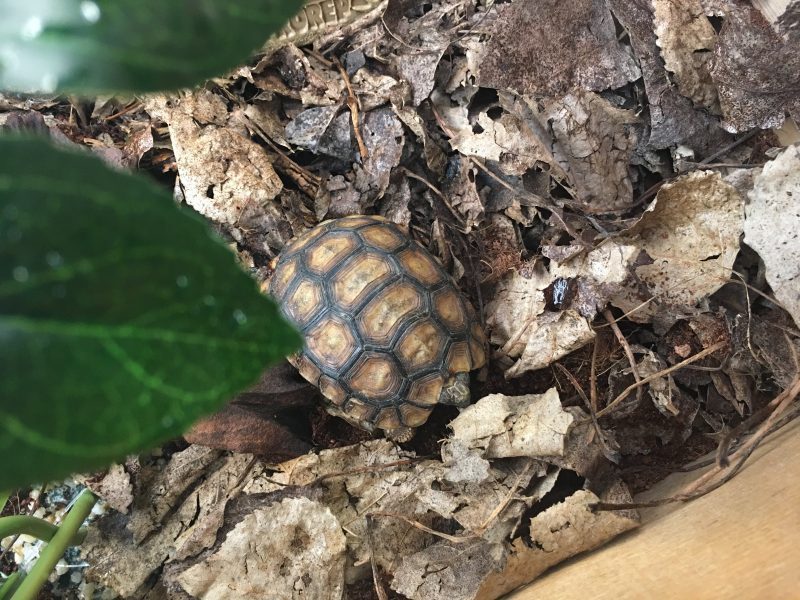Copyright 2021 Evolution Reptiles
All rights reserved.
Copyright 2025 Evolution Reptiles
All rights reserved.
All rights reserved.
The Bell’s Hingeback is a medium sized African tortoise, up to 22cm long, tan to light brown in colour with some patterning which fades with time. They are found across most of sub-Saharan Africa, favouring savannah, open woodland and grassland habitats that have a distinct wet and dry season.
As a tropical tortoise, they don’t hibernate the way that the more familiar Mediterranean species do, although in many parts of their range they do aestivate to escape the heat. They spend the dry season buried underground, in the mud of dried up waterholes, or tucked away beneath piles of logs or rocks.

The name ‘hingeback’ comes from the fact that they can close the back half of their shell to hide their back legs and tail. The shell has a flexible section at the fifth vertebra, and slopes sharply down from this point to give them their distinctive shape. They have large, dark eyes which give them an appealing expression, and are omnivorous.
Not only do they eat the sort of leafy greens that Mediterranean tortoises do, but they are also able to eat fruit, mushrooms, mealworms, snails and even – in the wild – carrion. A good diet for a young hingeback is 50% leafy greens/weeds, and 50% fruit/mushrooms/mealworms. Try different insects, snails, slugs, millipedes, and beetles, boiled eggs, bean sprouts and pea shoots.
Avoid the cabbage family due to the damaging goitrogens that they contain, and spinach because of the oxalic acid content.

All foods should have calcium supplement sprinkled on them, with a good quality multivitamin/multimineral supplement used twice a week.
In common with many tortoise species they will usually feed first thing in the morning, then retire into a shady area for the hottest part of the day, then emerge just before lights out to feed once again. Hingebacks are most active in the rainy season, so if they are a little reluctant to feed it’s worth giving them a good spray with tepid water to encourage them to become more active. Make sure they have a water bowl large enough to climb into, and shallow enough to climb out of!
They can be kept in vivariums, with a Viva+ terrestrial large deep being suitable for one tortoise. Offer them a substrate mix of soil, orchid bark and coir fibre, and make sure that there is a humidity gradient by keeping it slightly wetter at one end. They will also benefit from a good layer of leaf litter, and are a good candidate for a bioactive system.

They need access to full spectrum light, which can either be provided by a mercury vapour lamp if kept in a tortoise table, or a separate UV strip and basking bulb if in a vivarium. Daytime temperatures should range from 32ºC under the hotspot, with a background temperature between 24ºC and 28ºC. A night time temperature drop will benefit them greatly, but the temperature should not drop below 20ºC.
It’s a good idea to have an outdoor enclosure for them so that they can benefit from exposure to natural sunlight, and they will also appreciate being able to hunt for their own prey! When choosing which day to let your tortoise out into their outdoor enclosure, remember that they are a tropical species and cannot cope with cold.
Females will lay small clutches of 1 to 3 eggs several times in a season, and these have an enormously variable incubation period, from 90 to 100 days, or up to a year.
Common name: Bell’s Hingeback Tortoise
Scientific Name: Kinixys belliana belliana
Location: Sub-Saharan Africa
Habitat (wild): Grassland, savannah, open woodland
Captive environment: Table or vivarium
Preferred temperature range: daytime hot spot of 32℃ under the basking light, background ambient of 28℃, cool end of 24℃. Temperature can drop to 20℃ at night
UVB: 10% or 12% tube, mercury vapour or metal halide bulb
Ferguson Zone: Zone 3
Substrate: Soil based
Lifespan: 35 years +
Copyright 2021 Evolution Reptiles
All rights reserved.